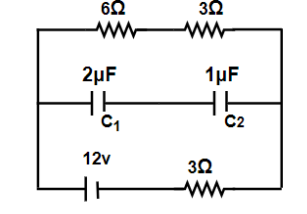
The charges stored in each capacitor

Answer
141.6k+ views
Hint: Find out the current flowing through the circuit which is given by the ratio of voltage to the equivalent resistance
Complete step-by-step answer:
Consider the capacitors as fully charged, then current is not drawn from the cell.
The equivalent resistance of the circuit is
Current of the circuit is given by,
Given that,
Hence the current in the circuit is 1A.
Now the potential across the capacitors is
The net capacitance between them is
Now the equivalent charge is given by
The capacitors are in series so the charge will be the same on both capacitors that is
The correct option is A.
Note: the effective capacitance in parallel grouping is given by,
For n identical capacitors in series,
In parallel,
Complete step-by-step answer:
Consider the capacitors as fully charged, then current is not drawn from the cell.
The equivalent resistance of the circuit is
Current of the circuit is given by,
Given that,
Hence the current in the circuit is 1A.
Now the potential across the capacitors is
The net capacitance between them is
Now the equivalent charge is given by
The capacitors are in series so the charge will be the same on both capacitors that is
The correct option is A.
Note: the effective capacitance in parallel grouping is given by,
For n identical capacitors in series,
In parallel,
Latest Vedantu courses for you
Grade 10 | CBSE | SCHOOL | English
Vedantu 10 CBSE Pro Course - (2025-26)
School Full course for CBSE students
₹37,300 per year
EMI starts from ₹3,108.34 per month
Recently Updated Pages
Young's Double Slit Experiment Step by Step Derivation

Difference Between Circuit Switching and Packet Switching

Difference Between Mass and Weight

JEE Main Participating Colleges 2024 - A Complete List of Top Colleges

JEE Main Maths Paper Pattern 2025 – Marking, Sections & Tips

Sign up for JEE Main 2025 Live Classes - Vedantu

Trending doubts
JEE Main 2025 Session 2: Application Form (Out), Exam Dates (Released), Eligibility, & More

JEE Main Exam Marking Scheme: Detailed Breakdown of Marks and Negative Marking

JEE Main 2025: Derivation of Equation of Trajectory in Physics

Electric Field Due to Uniformly Charged Ring for JEE Main 2025 - Formula and Derivation

Learn About Angle Of Deviation In Prism: JEE Main Physics 2025

Electric field due to uniformly charged sphere class 12 physics JEE_Main

Other Pages
JEE Advanced Marks vs Ranks 2025: Understanding Category-wise Qualifying Marks and Previous Year Cut-offs

JEE Advanced 2025: Dates, Registration, Syllabus, Eligibility Criteria and More

JEE Advanced Weightage 2025 Chapter-Wise for Physics, Maths and Chemistry

Degree of Dissociation and Its Formula With Solved Example for JEE

JEE Main 2025: Conversion of Galvanometer Into Ammeter And Voltmeter in Physics

Dual Nature of Radiation and Matter Class 12 Notes: CBSE Physics Chapter 11




